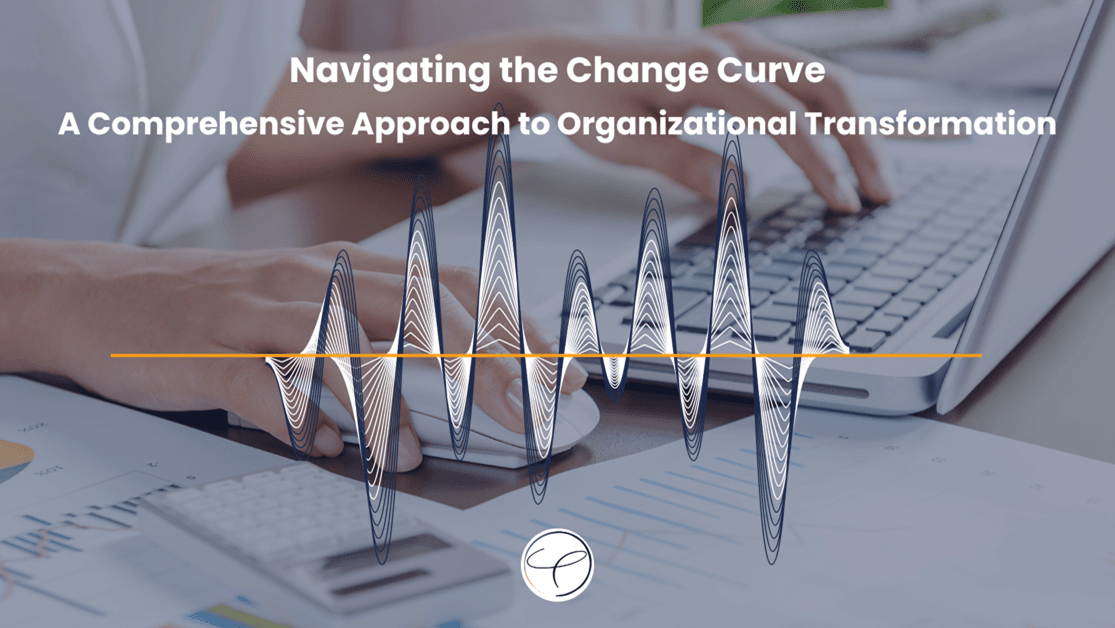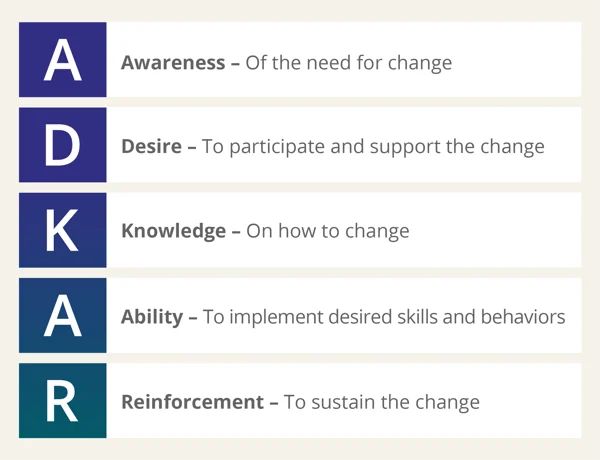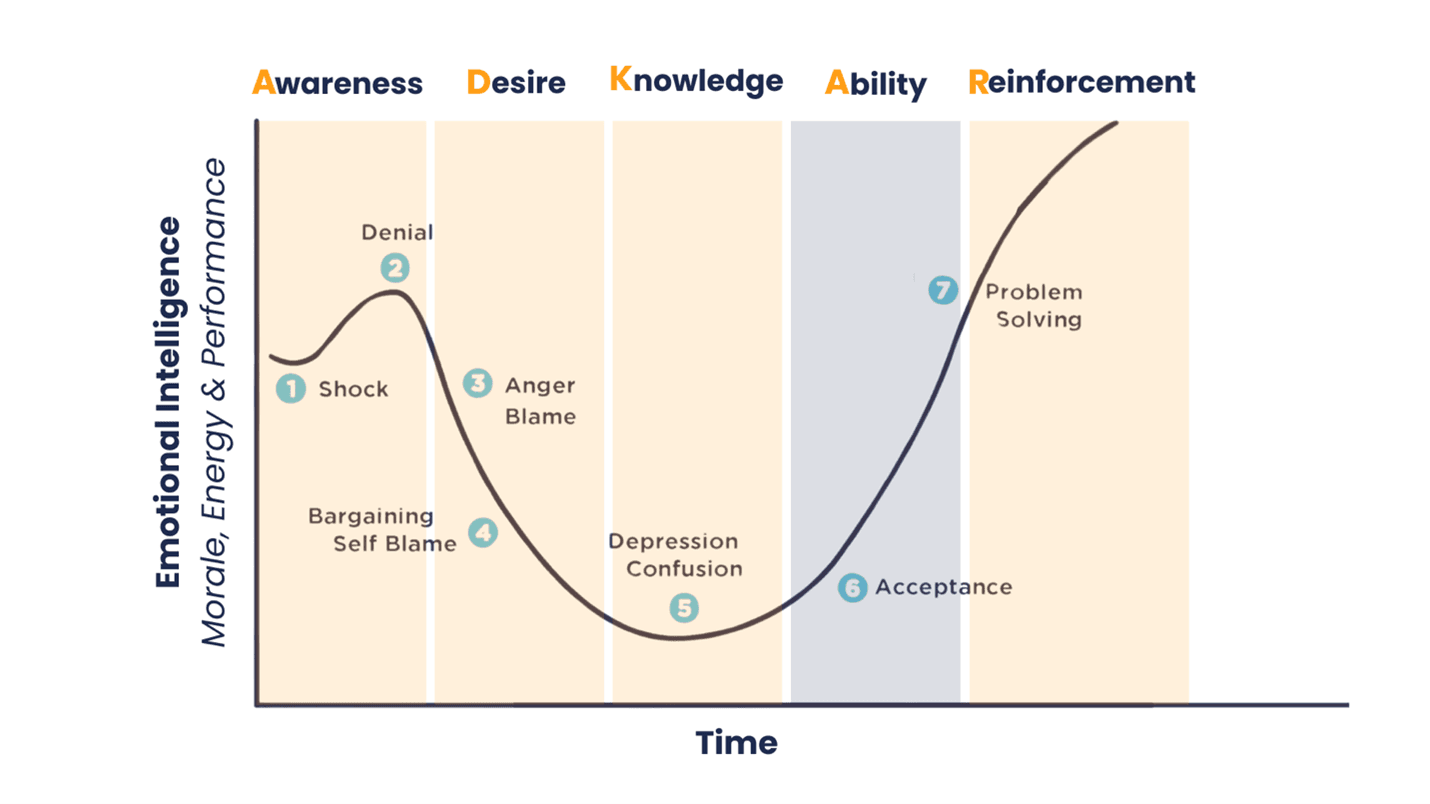

Change Management Blog
Navigating the Change Curve: A Comprehensive Approach to Organizational Transformation
October 14, 2024
Talal I. El-Assaad: Enterprise Transformation, CX Mastery & Go-to-Market Leadership

Navigating the Change Curve:
A Comprehensive Approach to Organizational Transformation
"Imagine leading your team through a major organizational shift, where success hinges not just on new processes, but on winning hearts and minds. How do you navigate both the emotional turbulence and practical challenges of change?"
In today's dynamic business landscape, managing organizational change effectively is crucial for success. The Change Curve model offers valuable insights into the emotional journey employees experience during transitions, but it's most powerful when integrated with comprehensive Change Management strategies. Let's explore how to leverage this model alongside other methodologies for successful transformations.
Understanding the Change Curve
The Change Curve, adapted from Elisabeth Kübler-Ross's model model of grief and terminal illness, (1969), has has been widely applied as a tool for understanding emotional responses to organizational change.
While the original model focused on five stages, the organizational change version expands this to seven stages, suggests a more nuanced approach to managing transitions in the workplace:

Shock: The initial, often stunned reaction to change announcements. (Not part of the Original)
Denial: Disbelief and refusal to accept the impending change.
Anger: Resentment and resistance towards the change, often accompanied by blame.
Bargaining: Attempts to negotiate or find ways to avoid the full impact of the change.
Depression & Confusion: The lowest point of the curve, marked by decreased morale and productivity.
Acceptance: Beginning to understand and come to terms with the new reality.
Problem Solving: Actively engaging with the change, finding meaning, and looking for positive outcomes. (Not part of the Original)
This expanded model provides leaders with a more comprehensive framework for anticipating and addressing emotional responses throughout the change process. By considering these potential stages, organizations may be able to tailor their Change Management strategies to support employees more effectively at each point in their journey.
Understanding this curve is crucial because:
- It helps leaders anticipate and prepare for various emotional reactions.
- It allows for more targeted interventions and support at each stage.
- It provides a roadmap for moving individuals and teams through change more smoothly.
- It emphasizes the importance of continued support even after initial acceptance, highlighting the need for reinforcement and problem-solving assistance.
By leveraging this expanded Change Curve model, organizations can create more empathetic, effective, and sustainable Change Management strategies, ultimately leading to smoother transitions and better outcomes.
Origins and Limitations of the Change Curve
While the Change Curve offers valuable insights, it's important to acknowledge its origins and limitations. Originally developed by Elisabeth Kübler-Ross to describe the emotional journey of terminally ill patients, the model has been adapted for organizational change. However, this adaptation comes with several caveats:
The emotional stakes in organizational change differ significantly from those in terminal illness scenarios.
There's limited empirical evidence validating the model's effectiveness in business contexts.
The model may oversimplify the complex ways individuals and groups respond to change.
It primarily focuses on negative emotions, potentially overlooking positive responses to change.
Cultural and individual variations may not be fully captured by this model.
Despite these limitations, when used thoughtfully and in conjunction with other Change Management tools, the Change Curve can provide a helpful framework for understanding potential emotional responses to change.
Understanding the link between Emotional Intelligence and Effective Change Management
The intersection of Emotional Intelligence (EI) and Change Management is crucial for effective leadership during organizational transformation. Leaders with high EI can recognize and manage their own emotions while navigating their teams' feelings, fostering trust and maintaining a positive atmosphere. This capability is essential when acknowledging fears without derailing the vision for change. Emotionally intelligent leaders demonstrate empathy by creating opportunities for meaningful dialogue, which strengthens relationships and encourages loyalty.
EI enables leaders to effectively communicate the vision and rationale for change by crafting narratives that resonate with team values, demystifying the process and mobilizing enthusiasm for shared goals. Managing their own emotional states allows leaders to guide teams through uncertainty with clarity. By integrating EI with a structured Change Management strategy, leaders enhance their ability to address the human aspects of transformation, complementing established models like the ADKAR model.
The Human Element in Change Management: Navigating the Change Curve
The Change Curve highlights the crucial human aspect of organizational transformation. This model recognizes that change is not just about processes and systems, but about people's emotions, reactions, and adaptations.
As individuals navigate these emotions, the following considerations can help them transition smoothly through the Change Curve:
Shock & Denial: Leaders must acknowledge that initial shock and disbelief are normal. This is the time for clear, empathetic communication about the reasons for change.
Anger: During this phase, it's crucial to provide outlets for expression and actively listen to concerns. Leaders should demonstrate emotional intelligence by validating feelings while still moving the change forward.
Bargaining: This stage presents an opportunity for involvement. Engage employees in finding solutions and allow them some control over how changes are implemented where possible.
Depression & Confusion: As reality sets in, support becomes critical. Offer resources, counseling if necessary, and continually reinforce the vision of a positive future state.
Acceptance: Even as people begin to accept change, continued reinforcement and celebration of progress are vital to prevent backsliding.
Problem Solving: Encourage and support employees in finding innovative solutions and adapting to the new normal.
Throughout this journey, leaders must infuse personal authenticity and empathy into change efforts. By understanding and anticipating these emotional stages, change managers can tailor their strategies to each phase, providing appropriate support mechanisms, identifying those struggling with the transition, and celebrating progress to reinforce positive behaviors.
Recognizing the constant state of flux in modern organizations, this human-centric approach to Change Management, helps create a more resilient and adaptable workforce. It transforms change from a purely operational exercise into a journey of collective growth and development.
Integrating Comprehensive Change Management: The Prosci Methodology and ADKAR® Model
While the Change Curve is valuable for understanding emotional reactions, it's not a complete Change Management strategy on its own. For more effective transformations, it should be paired with the Prosci structured Methodology which includes the ADKAR® Model.

The Prosci ADKAR® Model complements the expanded Change Curve by focusing on five key elements of successful individual change:
Awareness of the need for change
Desire to support the change
Knowledge of how to change
Ability to demonstrate new skills and behaviors
Reinforcement to sustain the change
By aligning ADKAR interventions with the Change Curve stages, organizations can provide targeted support throughout the entire change journey:
Creating Awareness helps address Shock and Denial
Building Desire aids in moving through Anger and Bargaining
Providing Knowledge assists in transitioning from Depression & Confusion to Acceptance
Developing Ability enhances Problem Solving
Reinforcement maintains progress and prevents regression
This integration leads to more successful and sustainable transformations.
Adapting the Framework to Different Types of Change
One of the key strengths of combining the Change Curve with Prosci's ADKAR® Model is its flexibility. Whether an organization is navigating a merger, digital transformation, leadership transition, or restructuring, this approach can be tailored to address both emotional and operational challenges. The seven-stage Change Curve allows for more nuanced interventions, while ADKAR provides a structured approach to supporting individuals through each stage.
For instance, in a digital transformation, the model helps employees understand new technologies while managing their anxiety about change. In mergers, it fosters unity by addressing cultural integration alongside practical adjustments.
Real-World Applications: Integrating Change Curve and ADKAR in Organizational Transformations
In my experience as a Change Management consultant, I have observed the powerful synergy that emerges when organizations effectively combine the insights from the Change Curve with the structured approach of the ADKAR model. This integration is particularly impactful in complex transformations such as digital overhauls and healthcare restructuring.

Consider a digital transformation scenario in a global technology company. By mapping the ADKAR model onto the Change Curve, change leaders can create a more nuanced and effective strategy. In the early stages, when employees are likely experiencing shock and denial, the focus is on building Awareness. This might involve data-driven presentations and industry trend analyses to help employees understand the urgency of digital adoption. As the organization moves through the anger and bargaining phases, the emphasis shifts to creating Desire for change. Leaders might highlight personal growth opportunities and conduct workshops on future skill requirements, addressing the emotional needs identified in the Change Curve while progressing through the ADKAR stages.
As the transformation progresses, the Knowledge and Ability components of ADKAR become crucial. During the depression and confusion phase of the Change Curve, comprehensive training programs and mentoring initiatives can provide employees with the tools they need to adapt, boosting both competence and confidence. Finally, as acceptance grows, Reinforcement strategies such as recognition programs and success story sharing can solidify the change.
In healthcare settings, where organizational restructuring often faces unique challenges, this integrated approach can be equally effective. By anticipating emotional responses through the Change Curve, healthcare leaders can tailor their ADKAR-based strategies more precisely. For instance, they might use town halls and department meetings to build Awareness during the shock and denial phases, then involve employees in decision-making processes to foster Desire during the anger and bargaining stages. Extensive training and support programs address the Knowledge and Ability components while helping employees navigate the depression phase, and robust feedback systems along with early win celebrations reinforce the change as acceptance grows.
The key to success in these scenarios lies in the flexible application of both models. By understanding that employees may move through the Change Curve at different paces and that ADKAR elements may need to be revisited, organizations can create a more adaptive and responsive Change Management strategy. This approach not only addresses the emotional journey of change but also provides a structured path for individual and organizational transformation.
Throughout my advisory work and whilst overseeing deployment initiatives, I have seen this integrated approach leading to significant improvements in change adoption rates, employee satisfaction, and overall transformation success. Organizations that skillfully blend these models often report smoother transitions, reduced resistance, and more sustainable long-term changes.
Many organizations have successfully navigated complex transformations by balancing emotional and practical approaches to change. By integrating the emotional insights of models like the Change Curve with a solid and structured Prosci methodology – including the ADKAR Model, these companies have managed to foster resilience, innovation, and long-term success. Below are examples of companies that have effectively combined these elements to drive successful organizational change.
“In my experience, the most effective change initiatives blend emotional intelligence with a structured Change Management methodology. This approach allows leaders to address both the human emotions and practical challenges of transformation, resulting in faster adoption and more sustainable outcomes.”
Key Themes in Modern Change Management
Recent trends in Change Management highlight the importance of:
Roles and Responsibilities: Clearly defining who is responsible for driving and supporting change
Integration with Project Management: Aligning Change Management efforts with project management practices
Methodology Selection: Choosing the right Change Management approach for your organization's specific needs
Strategies for Successful Change Implementation
To leverage the Change Curve effectively and ensure successful transformations:
Plan Thoroughly: Develop a comprehensive strategy that addresses both emotional and practical aspects of the transition
Maintain Transparency: Keep communication open and honest throughout the process
Personalize the Approach: Recognize that individuals move through the Change Curve at different paces
Empower Change Agents: Identify and support key individuals who can champion the change
Reinforce New Behaviors: Implement systems to sustain the change long-term
Recognize that individuals may experience change differently and not necessarily follow a predetermined pattern
In conclusion, while the Change Curve offers potential insights into emotional responses to change, its true power emerges when combined with an empirically-validated frameworks like the Prosci methodology.
This integrated approach leads to more successful and sustainable organizational transformations by addressing both the emotional journey and the practical steps needed for change. By leveraging both the Change Curve and Prosci's comprehensive Change Management methodology and tools, organizations can:
Address the full spectrum of change challenges, from emotional resistance to practical implementation hurdles.
Navigate common obstacles such as resistance to new technologies, competitive pressures, and integration difficulties in mergers and acquisitions.
Access a wider range of strategies, including clear communication, innovation focus, and specialized integration teams.
Benefit from expert guidance in implementing change strategies tailored to their specific organizational context.
Increase the likelihood of meeting or exceeding transformation objectives.
This balanced approach, while acknowledging the possible limitations of any single model, fosters a positive and resilient workplace culture. It equips leaders with the insights and tools needed to anticipate emotional responses, provide targeted support, and guide their teams through the complexities of change.
By understanding and effectively applying these complementary tools, organizations can navigate the turbulent waters of change with greater confidence, agility, and success. In today's rapidly evolving business landscape, this integrated approach to change management isn't just beneficial—it's essential for organizations aiming to thrive amidst constant transformation.
Ready to take your Change Management skills to the next level?
Download our free "The Prosci ADKAR® Overview " eBook!
Discover how to:
Apply the ADKAR model to your organization's unique challenges
Integrate ADKAR with the Change Curve for comprehensive Change Management
Accelerate adoption and maximize the success of your change initiatives
Don't miss this opportunity to transform your approach to organizational change!
RelatedBlog Articles
Top 8 Change Management Trends for 2024
What is Change Management?
Leading the Digital Healthcare Revolution: Citizen Perspective



